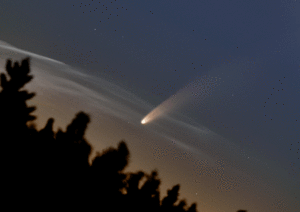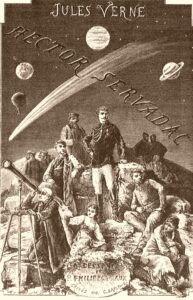
Comets fascinate me. They are wondrous visitors from the deep, cold fastness of space. The comet NEOWISE is in our sky now and it fills me with wonder. I have romantic ideas of space travel and seeking new adventures. But first, let’s quickly define some terms. Rogers (2013) provides some handy definitions.
- “Comet: A body of ice, rock and dust that can be several miles in diameter and orbits the sun. Debris from comets is the source of many meteoroids.
- Meteoroid: A small rocky or metal object, usually between the size of a grain of sand or a boulder, that orbits the sun. It originates from a comet or asteroid.
- Meteor: A meteoroid that enters the earth’s atmosphere and vaporizes. Also called a “shooting star.”
- Meteorite: A meteor that hits Earth without burning up in the atmosphere.
- Asteroid: An object larger than a meteoroid that orbits the sun and is made of rock or metal. Historically, objects larger than 10 meters across have been called asteroids.”
And some further clarity s provided by Imster & Byrd (2014). “Asteroids are generally considered to be made up of metals and rocky material, while comets are made up of ice, dust and rocky material. Both asteroids and comets were formed during the earliest history of the solar system, around 4.5 billion years ago. Asteroids formed much closer to the sun, where it was too warm for ices to remain solid. Comets formed farther from the sun where ices would not melt. Comets, which approach the sun, lose material with each orbit because some of their ice melts and vaporizes to form a tail. Asteroids typically remain much more solid and self-contained, even when near the sun.”
 Now, back to romance. When I was a kid, it was Jules Verne who excited my imagination. He wrote science fiction first. He was before H. G. Wells, Isaac Asimov, Robert A. Heinlein, Arthur C. Clarke or even Arthur Conan Doyle (Professor Challenger, The Lost World). Verne wrote Off on a Comet in 1877. A comet bumps into the earth and Gibraltar sticks to the comet as it bounces away from the earth. The people who are thus carried off into space take some time to figure out what happened and to design a way home. They build a balloon and then float back to earth when the comet passes close again. Now Verne was way short on science here but really big on the wonder of space travel.
Now, back to romance. When I was a kid, it was Jules Verne who excited my imagination. He wrote science fiction first. He was before H. G. Wells, Isaac Asimov, Robert A. Heinlein, Arthur C. Clarke or even Arthur Conan Doyle (Professor Challenger, The Lost World). Verne wrote Off on a Comet in 1877. A comet bumps into the earth and Gibraltar sticks to the comet as it bounces away from the earth. The people who are thus carried off into space take some time to figure out what happened and to design a way home. They build a balloon and then float back to earth when the comet passes close again. Now Verne was way short on science here but really big on the wonder of space travel.
No author, catches my imagination like Verne. I searched the book stores in Berkeley for Verne books (They were not very common when I was a kid). I found an omnibus copy of Robur the Conqueror and Master of the World and a French version of Robur the Conqueror. I tried to read the French version and used the English one to check myself. It was very slow going and while I eventually gave up, I did develop a greater appreciation for humor as it’s found in the French language.
References and Further Reading
- How to See Comet NEOWISE, NASA, July 14, 2020.
- How to Photograph Comet NEOWISE: NASA tips for stargazers, Chelsea Gohd, Space.com, July 15, 2020.
- Comet? Meteor? Asteroid? Here’s how to tell the difference, Paul Rogers, Mercury News, Bay Area News Group, March 10, 2013.
- What’s the difference between comets and asteroids?, Eleanor Imster and Deborah Byrd, Earth Sky: Space, June 26, 2014.
- Off on a Comet, Jules Vern, 1877, Wikipedia.
- Splinter (novel), Adam Roberts, 2007, Wikipedia. A re-telling of Off on a Comet.
- 10 deadly comets, asteroids and meteorites in the movies, Ryan Lambie, Den of Geek, June 14, 2011.
- Robur the Conqueror, Jules Verne, 1886.
- The Master of the World, Jules Verne, 1904. A note if you read any of Verne’s novels. He often uses racist language when referring to people from other cultures. No excuse for this.
- Professor Challenger, Wikipedia.
- Just for fun watch Georges Méliès’ 1902 silent film loosely based on Jules Verne’s 1865 novel From the Earth to the Moon and its 1870 sequel Around the Moon.

- Photo of NEOWISE – A naked-eye comet graces our skies, Mark Armstrong, Astronomy Now, July 7, 2020.
- An illustration from Jules Verne’s novel Off on a Comet (French: Hector Servadac, 1877) drawn by Paul Dominique Philippoteaux.
 |
| Visits: 22 |
